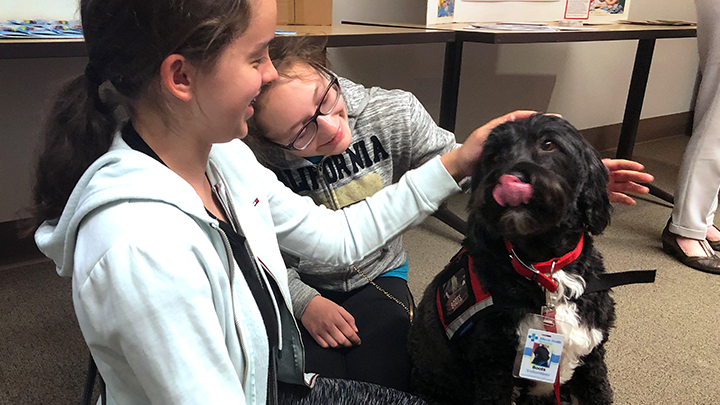
June 18, 2019

Guests at a recent Solutions for Kids in Pain (SKIP) event spent some quality time with Boots, a pet therapy dog with the Stollery’s Child Life Program. SKIP will provide children, families and healthcare professionals with solutions to minimizing pain and creating positive environments. With a $1.6M grant, the Stollery Children’s Hospital will be one of four hubs in Canada for SKIP.
Story and photo by Vanessa Gomez
EDMONTON — Hospitals can be a scary place for children. Fear of unknown spaces, unfamiliar faces and pain from needles or procedures are challenges faced by children and their parents.
A new initiative at Stollery Children’s Hospital — Solutions for Kids in Pain (SKIP) — is working to end these fears by putting evidence-based solutions into practice to help minimize children’s pain and give healthcare professionals and families easy access to pain-management information and tools.
The Stollery is now one of four hubs in Canada for SKIP, thanks to a $1.6 million federal grant and funding support from the Stollery Children’s Hospital Foundation, through the Women and Children’s Health Research Institute (WCHRI).
“Two-thirds of children in hospital experience painful procedures with no pain management, which can be traumatizing for not only the child, but for their families as well” says Dr. Samina Ali, a pediatric emergency physician and Western Canada’s SKIP Hub Lead at the Stollery.
“We’ve been able to identify specific pain-management strategies to help with these painful experiences, but translating those findings into practice within the hospital can be a challenge. With the help of SKIP, we’re able to speed up this process.”
Kathy Reid, a Clinical Nurse Specialist for Policy and Practice at the Stollery, has been working to improve the assessment and management of pain in children for more than 20 years.
“Procedure-related pain can increase anxiety for children and parents,” says Reid. “We are certainly hearing a lot about trauma from parents who have had to hold their children down during very painful procedures.”
It’s an anxiety that one mother, Brandie Thomas, knows all too well. Her son, Mason, was born with only half of his heart functioning, and required multiple procedures at just three-days-old. During a particularly stressful emergency, Thomas remembers feeling scared as she watched her seven-month-old baby endure painful prodding.
“It’s hard as a parent to watch that,” says Thomas. “You feel suffocated. You know it needs to get done, but it’s hard to see your child like that. It was years ago, but I still remember exactly how I felt.”
Due to this anxiety, some patients refuse procedures, may be less likely to diligently follow-up with after-care, or miss important vaccinations.
A recent culture shift has allowed certain practices to help young ones cope with procedure-related pain — things such as breastfeeding, skin-to-skin contact, numbing creams and, for older children, teaching them distraction and relaxation techniques — which are beginning to be integrated into wider practice.
The Stollery’s Child Life Program also provides children with the ability to cope with their circumstances. With therapy dogs, music therapy and play and self-expression activities, children are able to better understand their illnesses or procedures.
Working with families, healthcare providers, researchers, and policy-makers, SKIP will empower patients and their families through research and knowledge — giving them active voices in their care and the confidence they need to address any concerns with their medical team.
By improving children’s experiences with pain, healthcare professionals will continue to provide high-quality care that meets the needs of every patient.